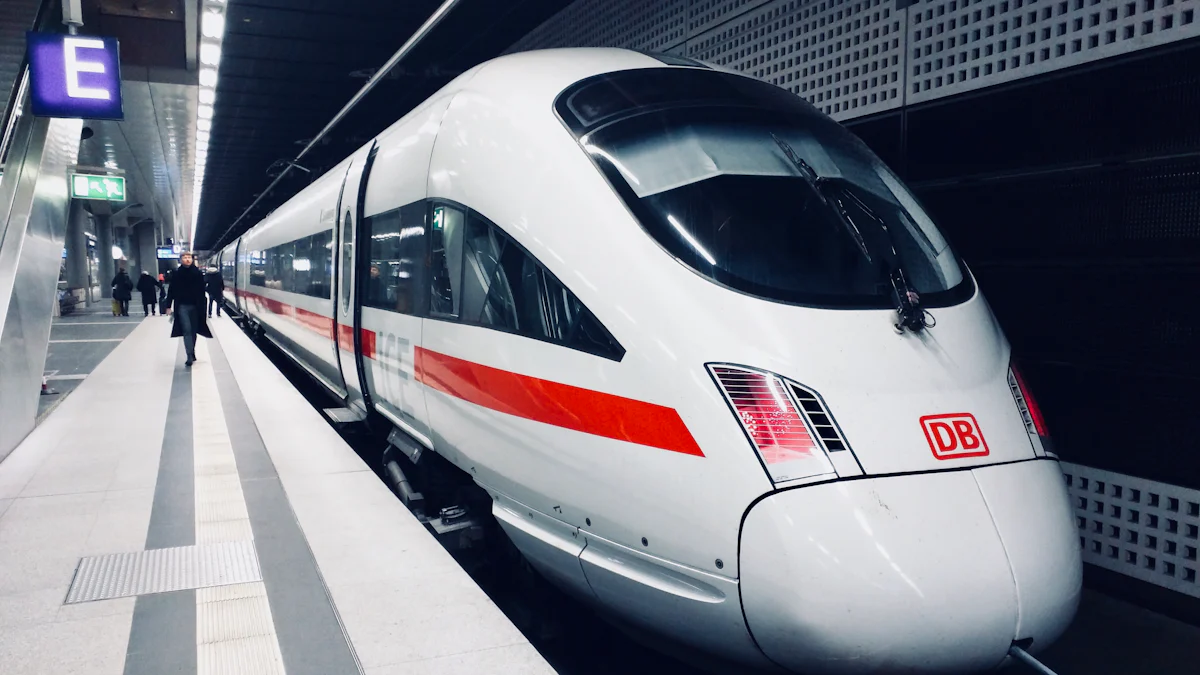The Future of Rail Transport: Insights from the China-Europe Railway

The future of rail transport plays a crucial role in global logistics, offering efficient and reliable movement of goods across vast distances. The China-Europe Railway, positioned as a green transportation option, is set to play a crucial role in global logistics, offering efficient, reliable, and environmentally friendly transport solutions that are well-supported by strategic partnerships, technological advancements, and government policies. This railway network has operated 77,000 freight trains over the past decade, transporting goods worth over $340 billion. Understanding future trends in rail transport is essential for anticipating shifts in global trade dynamics and optimizing logistics strategies.
Historical Context and Development
Evolution of Rail Transport
Early Innovations and Milestones
The history of rail transport began in the early 19th century. The first successful steam-powered locomotive, created by George Stephenson, marked a significant milestone in 1825. This innovation revolutionized transportation by enabling faster and more efficient movement of goods and people. The Stockton and Darlington Railway in England became the world's first public railway to use steam locomotives. This achievement set the stage for the rapid expansion of rail networks globally.
Impact of Industrial Revolution
The Industrial Revolution played a crucial role in the development of rail transport. The demand for efficient transportation of raw materials and finished goods drove the expansion of rail networks. Railways facilitated the movement of coal, iron, and other essential resources, fueling industrial growth. The introduction of standardized gauge tracks improved interoperability between different regions. This standardization allowed for seamless travel and trade across vast distances, further boosting economic development.
Emergence of the China-Europe Railway
Initial Conception and Planning
The conception of the China-Europe Railway emerged from the need to enhance trade connectivity between Asia and Europe. In 2011, the inaugural journey of the China-Europe Railway Express marked the beginning of a transformative mode of overland transportation. This initiative aimed to provide a reliable and efficient alternative to maritime and air freight. The planning phase involved extensive collaboration between multiple countries to establish a cohesive and functional rail network.
Key Milestones and Achievements
The China-Europe Railway Express achieved remarkable milestones over the past decade. By its 10th anniversary in 2023, the railway had successfully operated 77,000 freight trains, transporting goods with a total value surpassing $340 billion. This volume equated to 7.31 million TEUs (Twenty-foot Equivalent Units). The railway's achievements underscored its significance in global logistics and trade. The establishment of strategic partnerships and the integration of advanced technologies played pivotal roles in these accomplishments.
The historical context and development of rail transport highlight the transformative impact of early innovations and the Industrial Revolution. The emergence of the China-Europe Railway represents a significant advancement in modern logistics, offering a reliable and efficient transportation solution between two major economic regions.
Technological Advancements

High-Speed Rail Technology
Development and Implementation
High-speed rail technology has revolutionized rail transport. China has led the way with the largest high-speed rail network on Earth. Engineers have developed advanced trains capable of reaching speeds over 350 km/h. The implementation of this technology required significant investment in infrastructure. Engineers constructed specialized tracks, stations, and signaling systems to support high-speed operations.
Benefits and Challenges
High-speed rail offers numerous benefits. Passengers experience reduced travel times, enhancing connectivity between cities. Businesses benefit from efficient logistics, reducing transportation costs. High-speed rail also contributes to environmental sustainability by reducing reliance on air and road transport. However, challenges exist. The construction and maintenance of high-speed rail infrastructure require substantial financial resources. Operational challenges include ensuring safety at high speeds and maintaining punctuality.
Automation and AI in Rail Transport
Current Applications
Automation and AI have become integral to modern rail transport. In Beijing, an AI system processes real-time data with high accuracy. This system reduces rail movement caused by winds, supporting proactive safety prevention and precise maintenance. AI technologies like machine learning and deep learning provide intelligent equipment for high-speed railways. These technologies enhance construction, operation, and maintenance processes.
Future Potential
The future potential of AI in rail transport remains vast. AI could enable fully autonomous trains, reducing the need for human intervention. Predictive maintenance powered by AI could further improve safety and efficiency. Big data computing could optimize scheduling and routing, enhancing overall operational performance. The integration of AI promises to transform rail transport, making it safer, more efficient, and more reliable.
Economic and Environmental Impact

Economic Benefits
Trade and Commerce Enhancement
The China-Europe Railway significantly enhances trade and commerce between Asia and Europe. Rail freight offers a faster alternative to sea transport, completing journeys in about 12 days compared to 35-45 days by sea. This speed allows businesses to reduce inventory costs and improve supply chain efficiency. The railway network facilitates the movement of high-value goods, ensuring timely deliveries and boosting trade volumes. The integration of real-time monitoring and tracking technologies further enhances the reliability of rail freight, making it a preferred choice for many industries.
Job Creation and Economic Growth
The development and expansion of the China-Europe Railway contribute to job creation and economic growth. The construction and maintenance of rail infrastructure generate employment opportunities in various sectors, including engineering, logistics, and manufacturing. The railway also stimulates economic activities in regions along its route by improving access to markets and resources. Increased trade volumes lead to higher demand for logistics services, creating additional jobs and supporting local economies. Government subsidies and investments in rail transport further drive economic development, making the China-Europe Railway a catalyst for growth.
Environmental Considerations
Reduction in Carbon Footprint
Rail transport offers significant environmental benefits compared to other modes of freight transport. Railroads are four times more fuel-efficient than trucks, moving a ton of freight nearly 500 miles per gallon of fuel. This efficiency results in lower carbon emissions, contributing to global efforts to combat climate change. The China-Europe Railway's emphasis on green transportation aligns with energy-saving and emission reduction goals. By providing an eco-friendly alternative to road and air transport, the railway helps reduce the overall carbon footprint of global logistics.
Sustainable Practices and Innovations
The China-Europe Railway adopts sustainable practices and innovations to enhance its environmental performance. The use of 53-foot SOC containers improves transportation efficiency, reducing the number of trips required and minimizing fuel consumption. Advanced technologies for real-time monitoring of conditions such as temperature and humidity ensure the safe transport of sensitive goods, reducing waste and spoilage. The railway's commitment to sustainability extends to the development of new routes and services, optimizing logistics solutions to meet diverse market demands while minimizing environmental impact.
Challenges and Opportunities
Infrastructure and Investment
Funding and Financial Models
Funding rail infrastructure requires substantial financial resources. Governments and private investors often collaborate to secure the necessary capital. The Bipartisan Infrastructure Law provides significant funding for rail development and decarbonization initiatives. This law aims to integrate decarbonization efforts and achieve net-zero emissions in rail infrastructure. Private investors also play a crucial role by offering financial support through public-private partnerships. These partnerships help distribute the financial burden and ensure the completion of large-scale projects.
Maintenance and Upgradation
Maintaining and upgrading rail infrastructure is essential for ensuring safety and efficiency. Regular maintenance prevents accidents and reduces downtime. The Railroad Safety Enhancement Act of 2024 emphasizes safety enhancements and includes provisions for enrolling in the Confidential Close Call Reporting System. This system allows for proactive safety measures and precise maintenance. Upgrading existing infrastructure involves modernizing tracks, signaling systems, and stations. These upgrades improve operational performance and accommodate new technologies such as high-speed rail and automation.
Geopolitical and Regulatory Issues
Cross-Border Regulations
Cross-border rail transport faces complex regulatory challenges. Different countries have varying regulations and standards. Harmonizing these regulations is crucial for seamless international rail operations. The Staggers Rail Act of 1980 recognized the need for a balanced regulatory system that allows railroads to compete effectively. This act enables railroads to manage assets and price services competitively. International cooperation and agreements are necessary to standardize regulations and facilitate cross-border rail transport.
Political Dynamics and Cooperation
Political dynamics significantly impact rail transport. Cooperation between countries is essential for the successful operation of international rail networks. The Railroad Revitalization and Regulatory Reform Act aimed to make the rail regulatory system more responsive to changing circumstances. This act highlights the importance of adaptable regulations in fostering international cooperation. Political stability and strong diplomatic relations contribute to the smooth functioning of cross-border rail services. Collaborative efforts between governments enhance the efficiency and reliability of rail transport.
The China-Europe Railway faces various challenges and opportunities. Addressing funding and maintenance issues ensures the sustainability of rail infrastructure. Navigating geopolitical and regulatory complexities facilitates seamless international operations. Strategic investments and international cooperation will drive the future success of the China-Europe Railway.
The China-Europe Railway has revolutionized global logistics by enhancing trade connectivity between Asia and Europe. This railway network has significantly increased the stability of industrial and supply chains, acting as a stabilizer for global supply chains. The future of rail transport will likely see further technological advancements and expanded networks. These developments will continue to improve trade relations worldwide. However, challenges such as funding and regulatory issues remain. Addressing these challenges will unlock the full potential of rail transport, ensuring its pivotal role in global logistics.
See Also
Analyzing the Comprehensive Future of LTL Freight
Exploring Supply Chain Transport Tech: Are You Prepared?
Ready for the Transport Tech Revolution?
